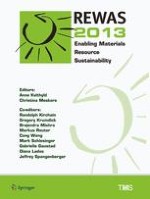2016 | Book
REWAS 2013
Enabling Materials Resource Sustainability
Editors: Anne Kvithyld, Christina Meskers, Randolph Kirchain, Gregory Krumdick, Brajendra Mishra, Markus Reuter, Cong Wang, Mark Schlesinger, Gabrielle Gaustad, Ph.D., Diana Lados, Jeffrey Spangenberger
Publisher: Springer International Publishing
